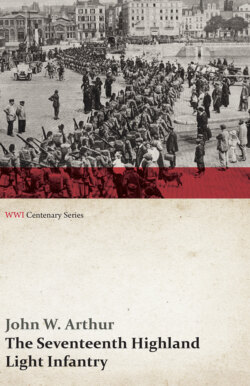Читать книгу The Seventeenth Highland Light Infantry (Glasgow Chamber of Commerce Battalion) (WWI Centenary Series) - John W. Arthur - Страница 15
На сайте Литреса книга снята с продажи.
ОглавлениеESPRIT DE CORPS.
It will be of value and interest to give here a brief survey of the history of The Highland Light Infantry, which enshrines a record of service and gallantry second to none in the annals of our Empire, and to which the Chamber of Commerce Battalion was fated to add a page as heroic and imperishable as any in its great traditions.
The Highland Light Infantry was originally raised as two separate Regiments of Foot, the 71st and the 74th. What was to become famous as the 71st was raised in 1777 by Lord John MacLeod and was known as “MacLeod’s Highlanders.” It was a kilted regiment and wore the Mackenzie tartan. It was originally numbered the 73rd, and under this designation won early distinctions in India in the campaigns against Hyder Ali and Tippoo Sahib. Nine years after its inauguration it became the 71st, and after service in Ceylon and at the Cape it received in 1808 the title of “The Glasgow Regiment.” Shortly after this the 71st entered once more the fields of war in the Peninsula campaign under Wellington, and shared in many actions including the storming of Ciudad Rodrigo, the siege of Badajoz and at Vittoria. Then came their crowning gallantry at Waterloo against the flower of Napoleon’s armies. In later years the Crimea, Canada and the Bermudas were added to their war honours.
The 74th was raised at Glasgow by Major-General Sir Archibald Campbell with a view to service in India. The 74th also wore the kilt, but of Black Watch tartan. Their record runs much on the same lines as that of the 71st, and quickly they are also found performing deeds of stubborn gallantry in India in the Mysore Territory. When the hour of Tippoo Sahib had come, the 74th was the first to enter the tyrant’s last stronghold, but it was later, at the battle of Assaye that they earned a fame which finds its echo to-day in the old badge of the Elephant, which that action entitles them to wear. For long afterwards the unit possessed the proud by-name of “The Assaye Regiment.” After sharing with the 71st in the rigours of the Peninsula, Canada and the West Indies, the 74th saw service in the Kaffir War, Madras, and in Egypt, including Tel-el-Kebir, where they were in the fiercest of the fight.
It was in 1809, as a reward for their services, that they were formed into Light Infantry, and were permitted to retain such parts of the national dress as were not inconsistent with the duties of Light Infantry. They then discarded the kilt and adopted the tartan trews which still appear in the full dress uniform of the Regiment. The kilt is now worn by two Territorial Battalions, the 6th and the 9th.
Subsequently the two Regiments were formed into one Regiment of two Battalions.
The “H.L.I.,” as all the world calls it, was of course present during the South African War. They fought at Modder River, and though they suffered severely at Magersfontein, continued to share in the hardships of the remainder of the campaign.
At the outbreak of the Great War there were in addition to the 1st and 2nd Battalions, two Special Reserve Battalions (the 3rd and 4th) and five Territorial Battalions, numbered the 5th, 6th, 7th, 8th and 9th.
After declaration of war, the 10th, 11th, 12th, 13th, 14th, 15th, 16th, 17th, 18th, 19th and 20th Service Battalions were raised, together with the 21st (Territorial) and 1st (Garrison) Battalions. In addition, the 5th, 6th, 7th, 8th and 9th Battalions each had second and third lines, and at one time there were as many as thirty Battalions in existence. These were more or less connected with the City of Glasgow and district, and serve as an indication of the patriotism and loyalty of the community.
On 14th December, 1914, the War Office issued an order that the Chamber of Commerce Battalion was to form a unit of the New Army, and was to be designated the 17th (Service) Battalion Highland Light Infantry, of the 117th Infantry Brigade, of the 39th Division. This intimation was received when the Battalion was stationed at Troon, and was hailed with great enthusiasm by all ranks.
Their comradeship in the common cause, their keenness for practical service and the esprit de corps engendered by their attachment to the illustrious Highland Light Infantry, knit all ranks together in enthusiasm and determination.
On the Sea Front at Troon.
Lt.-Col. David S. Morton, V.D., C.M.G.
Leaving Troon.
“Guard, Turn Out”—Wensley Camp.
Mess Orderlies—Prees Heath Camp.
It was about this time that instructions were received to recruit a fifth Company as part of the 17th Battalion establishment. As this Company eventually became the nucleus of a further Battalion with a parallel history of its own, it will be treated separately in another chapter.
